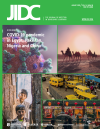Effect of social development in reducing tuberculosis mortality In northeastern Brazil areas
DOI:
https://doi.org/10.3855/jidc.12196Keywords:
Tuberculosis, Mortality, Social Development, Spatial AnalysisAbstract
Introduction: Tuberculosis (TB) is the primary cause of death among infectious diseases affecting groups in extreme poverty. Social improvements could reverse this situation in Brazil. This study aims to demonstrate the spatial relationship between social development (SD) and TB mortality in Natal, a city in northeastern Brazil.
Methodology: Ecological study. The study population comprised TB deaths recorded in the Mortality Information System between 2008 and 2014. The units of analysis were 59 human development units (HDUs). Raw and smoothed mortality rates were calculated using the global empirical Bayes method. Primary components analysis was used to develop the SD indicators. An association between TB mortality and SD was verified using multiple linear regression analysis. Spatial autocorrelation was verified using models with global spatial effects. Analyses were performed using Statistica version 12.0, ArcGIS version 10.2, Statistical Package for the Social Sciences version 20.0, and OpenGeoDa 1.0.1. The significance level was established at 5% (p < 0.05).
Results: The TB mortality rate with non-random spatial distribution ranged between 0.52 and 8.90 per 100,000 inhabitants. The spatial lag model was chosen because it presented the highest log-likelihood value, lowest AIC, and highest R2. A negative association was found between TB mortality and SD (R2 = 0.207; p = 0.03).
Conclusions: The results show a negative association between TB mortality and the high SD indicator. This study can support decision-making in terms of collective projects within public health in order to link the health field to other sectors, aiming for social well-being and human development.
Downloads
Published
How to Cite
Issue
Section
License
Authors who publish with this journal agree to the following terms:
- Authors retain copyright and grant the journal right of first publication with the work simultaneously licensed under a Creative Commons Attribution License that allows others to share the work with an acknowledgement of the work's authorship and initial publication in this journal.
- Authors are able to enter into separate, additional contractual arrangements for the non-exclusive distribution of the journal's published version of the work (e.g., post it to an institutional repository or publish it in a book), with an acknowledgement of its initial publication in this journal.
- Authors are permitted and encouraged to post their work online (e.g., in institutional repositories or on their website) prior to and during the submission process, as it can lead to productive exchanges, as well as earlier and greater citation of published work (See The Effect of Open Access).








